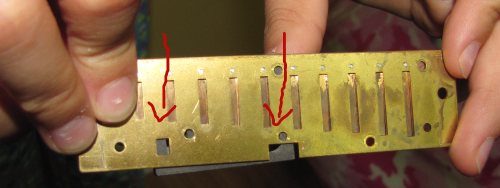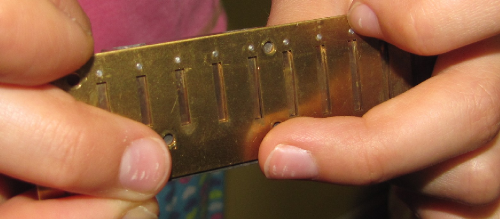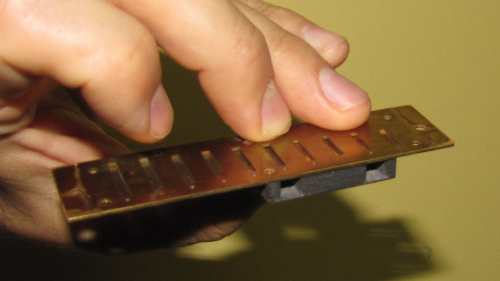
You don't need bulky, expensive and complicated equipment to tune your harmonica with great precision. The French Tuner™ helps you use your mouth and ears to quickly tune the blow reed plate of a diatonic harmonica. The French Tuner helps you eliminate beating and provide smooth chords.
Its precision design allows the French Tuner to work on all major brands of 10-hole diatonic harmonicas including Seydel (which have wider spaced holes) and many 12-hole harps.
Use it to help adjust reed profiles too! The French Tuner will isolate individual reeds and provide an airtight chamber for you to assess and make fine-grained changes to reed shape. Pucker or tongue-block embouchure can be used to best help you adjust your reeds to your playing style.
Order one here.
Use the French Tuner with my free harmonica tuning guide here:
Using the French Tuner:
The notes of the blow plate are organized in a repeating pattern. The root note, the third and the fifth. This pattern makes it very simple to tune the blow plate.

Hold the French Tuner over both notes of the octave and use your mouth to play both reeds at the same time or just one at a time. Lay the reed plate back down on your workspace and adjust the pitch of either note and recheck.

Precise tuning means you will be doing lots of small adjustments. The French Tuner allows you to quickly make adjustments and recheck the pitch of the reed without having to reassemble the harmonica every time.
Tips and Tricks:
Tip number one: Special 20 harps
On Hohner Special 20 harmonicas, the reed plate has extra openings next to a few slots to accommodate the recessed comb. This can cause an airleak when using the French Tuner to tune these notes. You may notice that these notes sound quieter or are harder to hit. This can make you unsure of how to tune them. But there is a very simple solution to this problem.

Just hold the French Tuner as usual and block the leak with your fingers. Just be sure to not cover up the slot.


Tip number two: As you go up...
You will notice that you will need to keep a larger difference between the pitch of both notes of lower octaves than the difference in pitch on higher octaves. Use these example values to get the idea: Tune hole 4 right on pitch. Tune hole 1 about 2-5 cents sharper than hole 4, depending on the key. Tune hole 7 about 1-2 cents flatter than hole 4. Tune hole 10 about the same as hole 7, maybe a hair to the left. It will be flatter, but your tuner may not pick it up. Use your ears and the flowchart to eliminate beating.
Be careful with your breath force. The French Tuner creates an airtight seal on the blow chambers. Once you put the reed plate back on the comb, the channel will not be so tight any more because the draw reeds will create more of an open space. When using the French Tuner, keep light breath force to avoid tuning the reeds a little sharp.
The reed profiles of the top octave may be such that those reeds only respond to harder breath. In that case, you will always have trouble getting the tuning to be perfect. In that case, focus on the lower octaves and tune the top octave when the plates are assembled to the comb using the Five Cent Tuner to make very small adjustments.
Tip number three: The waiting game
Be patient. Tune the harp and let it be for a few days before you attempt to adjust the tuning again. In the long run, that will save you a lot of time and avoid some confusion or frustration.
Enjoy tuning your harps the easy way!